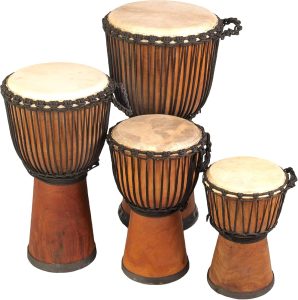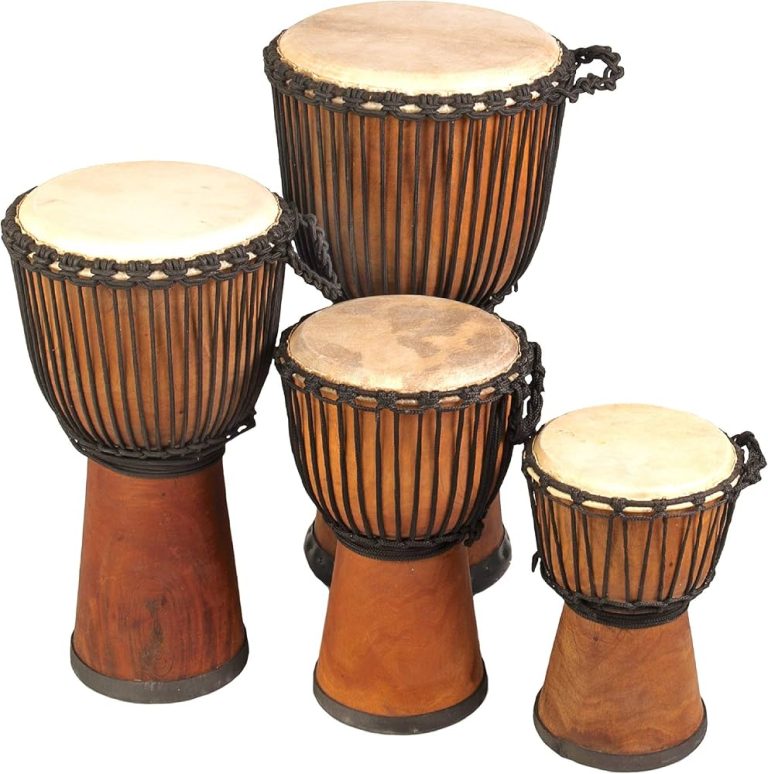


*Djembe* (your “Djemb”)
The djembe is a goblet-shaped hand drum that originated with the Mandinka people of West Africa around 1300 AD during the Mali Empire . According to the Bambara people in Mali, the name “djembe” comes from “Anke djé, anke bé,” meaning “everyone gather together in peace” .
The drum’s origin is associated with the Numu, the Mandinka caste of blacksmiths . Initially, it was played only during the smelting of iron ore, but over time its popularity grew beyond the Numu caste . The djembe is carved from a single piece of African hardwood and topped with an animal skin drumhead, traditionally goatskin . Until the 1950s and decolonization of West Africa, the djembe was known only in its original area due to limited travel .
*Burru Drums* (Historical African-Jamaican tradition)
Burru drum ming uses three types of drums: Bass drum (which carried the rhythm), Fundeh drum (which added syncopation), and Repeater drum (which brought in the melody). The first Burru drums were heard on Jamaica in 1903 in the parish of Clarendon . The Burru were a group of African drummers permitted by slave owners to play drums for workers in the fields .
Burru is an Afro-Jamaican folk music form maintaining much of its African origins, specifically from the Ashanti (Akan) people of present-day Ghana . *Importantly*: The three drums used in Nyabinghi directly derive from Burru drums, with Count Ossie incorporating Burru influences .


The *Repeater* (also called *Akete, **Kete,
## *Physical Characteristics*
The repeater is similar in size to the funde drum, but has a tighter drum head, which gives it a higher note . The drums are double-membraned, with heads generally made of goat skin . It is the smallest and highest pitched of the three Nyabinghi drums .
## *Playing Technique*
The repeater is held on the floor between the knees and played with the hands, specifically with the fingertips (unlike the funde which is played with the palms) . The drummer improvises but mainly emphasizes beats 2 and 4 .
The Ashiko Drum
originated in Yoruba culture in present-day Nigeria and Benin, with its name derived from a Yoruba word meaning “drum” or “freedom.” Traditionally, it functioned in community celebrations and as a “talking drum.” Historically, ashikos were hand-carved from single logs of wood, creating natural resonance chambers that enhanced sound quality.
The ashiko first disseminated in the United States during the 1930s after Nigerian drummer Moses Mianns emigrated to New York. However, the drum gained widespread popularity in the 1950s-60s through Yoruba musician Babatunde Olatunji’s touring folkl ensemble, which appeared on his groundbreaking album “Drums of Passion.”
Similar drums are found in Afro-Caribbean and Afro-Latin American cultures due to the Atlantic slave trade, including Cuban variants and Brazilian timbaus. Today, the ashiko remains a versatile instrument celebrated in world music, drum circles, and contemporary performances worldwide.


The Dunun, also known as Djun-Djun, Dundun, or doundoun,
is a West African bass drum family instrument, typically made from a wooden shell with cowhide as the drumhead. It is a closed double-headed cylindrical-shaped African drum invented along with the Djembe drum.
In West African countries like Guinea, the dundun comes in three different sizes with distinct names: the Kenkeni (small, high-pitched), the Sangba (middle), and the Dudumba (large, low-pitched). Although traditionally each dundun was played by a separate player, the three may be linked together and played vertically using two sticks in a style known as “Ballet Style.”
In a typical ensemble, the bass drums, or dundun, are usually played with sticks and provide the core structure of the rhythm. The dundun drums are not tuned as high as the djembe drum and provide the bass notes or lower end to complement the high-pitched sound of the djembe in African drumming ensembles.